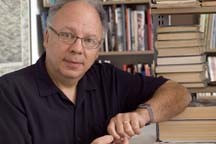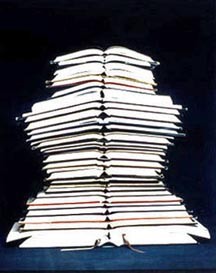The Buzz on book arts: Spector creates with words, books, authors
By Dan Aloi
Hand Buzz Spector a book, and there's a good chance he will destroy it.
The Cornell art professor and art department chair has meticulously torn the pages of hundreds of books to create cascading images within their bindings.
"This is a graphic effect, like a shading exercise," Spector says in his Tjaden Hall studio. "I come from a family of knitters; never underestimate the value of obsessive-compulsive disorder on being an artist."
He transformed "They Called Her Styrene," a book of artist Ed Ruscha's text paintings, from a six-sided object to a five-sided one, its covers coming to a point. His work has a rhythm, related to his background as a percussionist.
Spector has a particular interest in text as art, showing words with materials, including yarn, embossed paper and, in one installation, painted ceramic tiles in a train station. In one of his early pieces, "Memories," he had each line of a poem printed onto a different pencil so the lines could be rearranged. This year he produced a 30th anniversary edition of the piece.
He has published prints of close-up images of authors' ears, and shown art installations that include scrims hung with dust jacket photos of authors' faces, over which he projected film of a hand putting pen to page. He worked with a cigar-box maker to design an elaborate box, complete with a secret compartment, for a 1992 deluxe limited edition of a Joseph Cornell book for Grassfield Press.
For "Crenshaw Stories" (1998), commissioned for a new rapid transit station in South Central Los Angeles, Spector talked with residents about the neighborhood and its history, collected their stories, and had local sign painters letter the tiles in the Crenshaw Station underpass. "We all lettered the stories in 11 different languages, all of them spoken in the area," Spector says.
In addition to altering books in the name of art, Spector has produced a few of his own, including "The Book Maker's Desire" (1995, Umbrella Press), a collection of essays on the art of the book; and "Details: closed to open," presenting photographic details in images from the Swarthmore Peace Collection.
Spector came to Cornell four years ago from the University of Illinois; he also taught at the Art Institute of Chicago.
"We have much more talent at the undergraduate level here than I encountered at the Art Institute, [which was] the No. 1 ranked school in the country," Spector says. "So we don't get our due."
Being an administrator and an artist can be a tough balance, he says: "It messes up my loitering time. I can't lie around and go through magazines and walk around and daydream. I find myself on an airplane, doodling on a cocktail napkin."
His studio also boasts his library of artists' books, plus artwork by Sol Lewitt and by writer David Sedaris, "one of my favorite students [at the Art Institute]," Spector says.
Spector has recently exhibited in Chicago and in Portland, Ore., and will have work on display at Ithaca's State of the Art Gallery in January.
Media Contact
Get Cornell news delivered right to your inbox.
Subscribe

